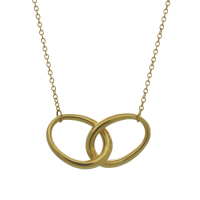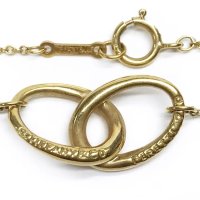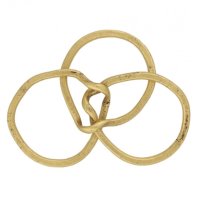I’m noticing some strong similarities between several Tiffany and Cartier collections, specifically DBTY from Tiffany vs. Diamants Leger from Cartier and the interlocking necklace concept of 1837 and Atlas from Tiffany vs. interlocking Love necklace from Cartier. I know DBTY debuted in 1974 but not sure the year of Diamants Leger. Also, I know the Cartier Love bracelet debuted in the 1970s but am not sure when the interlocking necklace iteration debuted. (I’m presuming the bezel diamond necklace and interlocking circles motif predated their debuts at T/C but am particularly curious which of the two houses established their interpretation.) Thanks so much! I wish the companies’ respective websites gave more details about their collections.
You are using an out of date browser. It may not display this or other websites correctly.
You should upgrade or use an alternative browser.
You should upgrade or use an alternative browser.
Tiffany vs. Cartier: Who Copied Whom?
- Thread starter unhly_msqurade
- Start date
TPF may earn a commission from merchant affiliate
links, including eBay, Amazon, and others
More options
Who Replied?I’d be interested to know this! I have the interlocking Love necklace with diamonds and always assumed that the design started with Cartier, but have no actual basis for that assumption 

I just recently noticed the interlocking rings on Tiffany's site. I'm pretty sure it is new, or at least new-ish. It does look to me like Tiffany copied Cartier. I don't compare their solitaires though since I think that's just a classic piece and they look different enough to me that one doesn't look like a dupe of the other.
I love a lot of Tiffany designs, but I suspect it started with Cartier, too!I’d be interested to know this! I have the interlocking Love necklace with diamonds and always assumed that the design started with Cartier, but have no actual basis for that assumption
Good point about how classic diamond pendants are!I just recently noticed the interlocking rings on Tiffany's site. I'm pretty sure it is new, or at least new-ish. It does look to me like Tiffany copied Cartier. I don't compare their solitaires though since I think that's just a classic piece and they look different enough to me that one doesn't look like a dupe of the other.
I have no idea. I would be interested to know too. Right now I’m gutted bc of Tiffany’s recent price increase. I know, first world problems.
Tiffany is an older company than Cartier and in my opinion Tiffany has better jewelry but I don’t know who was first for this design style. You should visit the stores to try them both and then decide which one you like the best. Both are great brands and I don’t think you can go wrong with either brand.
so i happened to wander into tiffany's with some girlfriends who wanted to look at diamonds...and picked up their spring catalog to peruse through later. in it, i found something i'd never seen before, an interlocking ring necklace that reminds me so much of the cartier love neacklace i've always lusted over - for a fraction of the price! i not so subtly pointed it out to DH who bought it for me for valentine's day. turns out, it's not listed online, sold out in the tri-state area, and was just released! as DH says, i always seem to pick the most difficult things to find. after much searching, he managed to get it shipped from the tiffany's phone number...and bought it for me even though i just bought myself a LV mizi! here's my new interlocking circles pendant! i'm planning on getting elongated by an inch or two later today (it's 16" and i prefer 18")
I don’t think interlocking circles is a distinct design that requires any copying. Same with a bezel set diamond. There are probably countless iterations of concentric circles in a pendant that Tiffany and Cartier have made since their inception. And also countless versions of bezel set diamonds on a chain.
It doesn’t take revolutionary inspiration to come up with the designs independently. Just look at this vintage Peretti design that also features interlocking rings. Also, if you look at Tiffany’s jazz collection, which is based off their Art Deco jewelry, the popular use of bezel settings in their pendants has existed for at least a century.
Same with Cartier. Their trinity ring has existed since the 1920s, which features three interlocking rings. You add a chain through it and boom, you have a necklace. I think it’s easy to infer from this that a double ring design would have preceded this. And bezel settings, again just in general, have been around for hundreds of years.
Using this forum as a benchmark, there are many, many, many more posts about DBTY than diamants legers. The oldest post about DBTY is from 2007. And the oldest post about diamants legers is in 2010. So it seems Cartier introduced their design later, and Elsa Peretti is the OG.
As for whether the love pendant came out first, or the atlas pendant, or 1837 pendant. I think that’s harder to pinpoint. The juste un clou collection was launched in 2012. So it seems that its release would have happened after Cartier expanded the love collection. I have a feeling that Cartier stuck with the purist love bracelet for a good amount of time, before adding other categories, considering the whole point of the love was to have a screw feature that someone else could put on you. Also, I remember that the love bracelet was first pitched to Tiffany, but they didn’t like the design, so it ended up going to Cartier instead. If this is the case, I wonder if Tiffany already had other designs featuring simple or industrial geometry at this time. The hardware chain and ball bracelet was designed around this time, so I don’t know what the Tiffany executives were thinking when they rejected the love design. Maybe it was redundant, or too simple, or too cumbersome. Who knows.
Anyway, there are early posts which mention the similarity between the 1837 pendant and the love pendant. The oldest post about an 1837 or Atlas pendant is from 2006. Originally, I was inclined to think that the love pendant was a much later addition compared to the atlas and 1837 pendants. Tiffany tends to introduce full fledged collections. Meanwhile, Cartier still hasn’t introduced some categories in all their new collections. But based on old posts, it seems that the 1837 pendant came after the love pendant was already on the market. However, there’s little indication of whether atlas or love had a pendant in their collection first.
But if we want to really go down the “who inspired who” rabbit hole, the trinity necklace appears to precede the love necklace. But it has three rings, so I’m not sure if you would consider that to be an original source of inspiration.
And then there’s the Elsa Peretti necklace, designed in the 70s-80s. This might be considered the OG interpretation of a commercialized, double-ring pendant. But it uses ovals instead of circles, so I don’t know.
Anyway, the point is that these designs aren’t really that unique. If you want to nitpick, the popularity of DBTY seems to be the inspiration behind diamants legers. There seems to be a stronger case there.
But the double ring design of love and atlas doesn’t seem to have a clearcut answer. The pendants in these collections (including trinity) were probably (definitely) afterthoughts. An interlocking design is one of the simplest ways to transform a bracelet or ring into a pendant. If you look at the individual components, a love ring, an 1837 ring, and an atlas ring all have features that look independent of one another. It just so happens that doubling them up makes the three necklaces look a lot more similar than they probably were intended to be. I would liken these similarities to convergent evolution, or parallel conduct. I think the case is not as strong or evident as to who was the original trendsetter for popularizing that look.


Last edited:
Good analysis. From a jewelry history perspective, the circle is basically the oldest motif, and interlocking circles have been used for centuries. For example, the ring below offered by Berganza and dated to around 1650-1700. Industrialization allowed for the mass production of chains (previously quite labor intensive). At that point, it was inevitable that interlocking ring pendants would proliferate in commercial jewelry (just like other old motifs, e.g. circles, hearts, knots, etc.). Every commercial jeweler has their spin on it, but I don’t think anyone can claim ownership.Anyway, the point is that these designs aren’t really that unique. If you want to nitpick, the popularity of DBTY seems to be the inspiration behind diamants legers. There seems to be a stronger case there.
But the double ring design of love and atlas doesn’t seem to have a clearcut answer. The pendants in these collections (including trinity) were probably (definitely) afterthoughts. An interlocking design is one of the simplest ways to transform a bracelet or ring into a pendant. If you look at the individual components, a love ring, an 1837 ring, and an atlas ring all have features that look independent of one another. It just so happens that doubling them up makes the three necklaces look a lot more similar than they probably were intended to be. I would liken these similarities to convergent evolution, or parallel conduct. I think the case is not as strong or evident as to who was the original trendsetter for popularizing that look.

Register on TPF! This sidebar then disappears and there are less ads!
